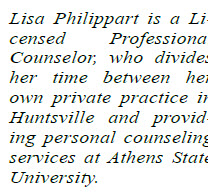 By: Lisa Philippart
By: Lisa Philippart
Since March, I have been trying to attend at least one free webinar a week related to mental or emotional health. Most have been helpful, providing new tidbits of information that I can use in my counseling sessions. Two weeks ago, this poem was included in a webinar on choices and responsibility; and it has already had a profound impact on me and now my clients. I’m almost embarrassed to report that I was not aware of this poem, but now that I am, I am sharing it with everyone! Take a moment to read it through. Then read it again.

Autobiography in Five Short Chapters
Chapter 1
I walk down the street.
There is a deep hole in the sidewalk
I fall in.
I am lost … I am helpless.
It isn’t my fault.
It takes me forever to find a way out.
Chapter 2
I walk down the same street.
There is a deep hole in the sidewalk.
I pretend I don’t see it.
I fall in again.
I can’t believe I am in the same place
but, it isn’t my fault.
It still takes a long time to get out.
Chapter 3
I walk down the same street.
There is a deep hole in the sidewalk.
I see it is there.
I still fall in … it’s a habit.
My eyes are open
I know where I am.
It is my fault.
I get out immediately.
Chapter 4
I walk down the same street.
There is a deep hole in the sidewalk.
I walk around it.
Chapter 5
I walk down another street.
Copyright 1993, by Portia Nelson from the book,There’s A Hole in My Sidewalk.
Making mistakes is a natural part of life, and an important part of understanding the process of learning. This poem is about identifying, analyzing, and learning from our mistakes. In the first chapter, the person doesn’t even see the hole and is completely lost. There are times when we blame someone else instead of facing reality. It can be a challenge to see ourselves as the performers of our actions, which causes us to be “inside the hole.” It’s easier to blame someone else and run from the problem as a victim. If we look at the poem symbolically, the street represents life and the hole represents trouble or a struggle. And in chapter one, it’s all about feeling helpless.

In the second chapter, the person pretends not to see the hole and falls into it again. The hole is there and even if the person falls into it, the person is pretending he is not the doer. Falling in is not our fault. Making a mistake can become a habit, and life gives us opportunities to learn from our mistakes. In some cases, it takes some or a long time for us to learn. It depends on our learning processes, culture, genetics, attitudes, etc. But everybody has the potential to learn. Wanting to change is the important issue, and this person isn’t there yet.
By the third chapter, the person recognizes the hole, falls into it, but finally realizes that it’s a habit. The “eyes are open” to the awareness of the action, understanding who has just performed the action of falling. The need to get out of the hole symbolizes the will to do things differently. The person sees that he is in an uncomfortable position and it’s his fault. At this point in the story we recognize the frustration and understand the reason for the fall. Acknowledging our mistakes is really important, and once we do that, we can start acting differently and take responsibility for our own deeds. This chapter is our “wake up call!”
Chapter four is when the person decides that he/she is not going to fall into the hole again (make the same mistake, act the same way and get the same result.) We have a new perspective.
In the last chapter, the person is taking another way, making a change, and moving on with life in a new direction. Once we face difficult situations, we have the opportunity for new outcomes. This autobiography shares the simple analogy that change cannot take place until we take responsibility for our actions.
By: Lisa Philippart
Licensed Professional Counselor


